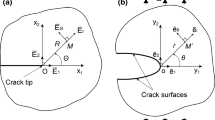Abstract
A method of algorithm of numerical analysis of supercritical crack growth are proposed. They make it possible to determine the release of elastic energy and the rate and direction of crack growth with an allowance made for residual stresses. Crack growth was simulated by means of finite elements with special properties. The results of calculations carried out using this algorithm were compared with analytical dependences and experimental data on crack propagation with constant and variable rate.
Similar content being viewed by others
Literature cited
V. V. Panasyuk (ed.), Fracture Mechanics and Strength of Materials, a Handbook [in Russian], Vol. 1, Naukova Dumka, Kiev (1988).
M. Siratori, T. Miesi, and H. Matsusita, Computing Fracture Mechanics [Russian translation], Mir, Moscow (1986).
F. Maclintock and A. Argon, Deformation and Failure of Metals [Russian translation], Mir, Moscow (1970).
V. Z. Parton and V. G. Borisovskii, Dynamics of Brittle Fracture [in Russian], Mashinostroenie, Moscow (1988).
G. P. Karpzov, V. A. Karkhin, V. P. Leonov, and B. Z. Margolin, “Calculation of crack trajectory and the rate of release of elastic energy in cyclic loading taking welded stresses into account,” Probl. Prochn., No. 9, 104–109 (1983).
V. I. Kostylev and B. Z. Margolin, “FEM solution of a dynamic elastoplastic problem of fracture mechanics. Report 1, dynamic elastoplastic problem,” Probl. Prochn., No. 7, 6–11 (1990).
E. Yoffe, “The moving Griffith crack,” Phil. Mag.,42, No. 330, 739–750 (1951).
Fracture [Russian translation], Vol. 2, Mir, Moscow (1975).
T. Nishioka, R. B. Stonesifer, and S. N. Atluri, “An evaluation of several moving singuslarity finite element models for fast analysis,” Eng. Fract. Mechn.,15, No. 1–2, 205–218 (1981).
K. Hellan, An Introduction into Fracture Mechanics [in Russian], Mir, Moscow (1988).
J. Kalthoffe, J. Deinerg, and S. Winkler, “Measurement of the dynamics stress intensity factor for rapidly propagating and arrested cracks in double cantilever beam specimens,” in: Novoe Zarubezh. Nauk. Ser. Mekh. Razrush., No. 25, 23–41 (1981).
Author information
Authors and Affiliations
Additional information
Translated from Problemy Prochnosti, No. 7, pp. 12–19, July, 1990.
Rights and permissions
About this article
Cite this article
Kostylev, V.I., Margolin, V.Z. FEM solution of a dynamic elastoplastic problem of fracture mechanics. 2. Supercritical crack propagation. Strength Mater 22, 943–953 (1990). https://doi.org/10.1007/BF00767538
Received:
Issue Date:
DOI: https://doi.org/10.1007/BF00767538




